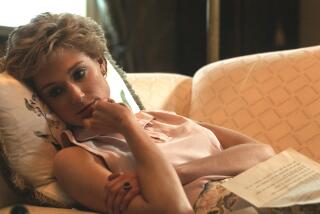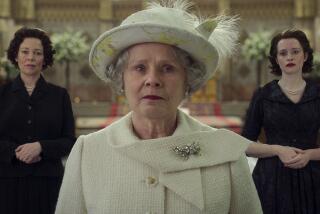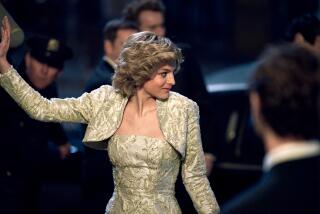Op-Ed: Diana 20 years later: Still rubbernecking

Diana, Princess of Wales died on this day 20 years ago due to cardiac arrest following a car crash. (Aug. 31, 2017) (Sign up for our free video newsletter here http://bit.ly/2n6VKPR)
Princess Diana has been a staple of headlines for so long that articles and documentaries marking the 20th anniversary of her death may seem unremarkable. But the coverage is more than a stream of TV shows and newspaper and magazine special editions. It’s a meta reminder of the extremes that media coverage of Diana reached during her lifetime, and of the overexposure that continued after her death.
Diana was a 19-year-old nursery school teacher when she started dating Britain’s future king — and became a media sensation. Prince Charles bowed to pressure and proposed even though they had seen each other only about a dozen times. On their wedding day, the archbishop of Canterbury intoned, “Here is the stuff of which fairy tales are made.” But the tale was already doomed: Diana later revealed that her bulimia had started the week after the engagement and that she struggled even then with Charles’ relationship with Camilla Parker-Bowles.
Before Charles proposed, Diana was tight-lipped with the press. Over time, though, as she attracted bigger crowds than her husband and his jealousy contributed to the rift in their marriage, she found support in media praise. She cultivated journalists and planted stories. The cold war of the royal marriage and affairs played out for years in newspaper revelations and scandals. Media hounding only increased after they split, and Diana’s decision to give up her royal bodyguards left her vulnerable to aggressive paparazzi.
The breadth and depth of adulation Diana inspired was new — and so was the insistence with which she was stalked.
“I believe she cried more to do with the press intrusion than anything else in her life. The impact it was having on her that we would then see and feel was very difficult to understand,” her older son, Prince William, said in a recent BBC documentary.
“She was subjected to treatment that frankly nowadays people would find utterly appalling,” he said. “Every single time she went out there’d be a pack of people waiting for her. I mean a pack of dogs, followed her, chased her, harassed her, called her names, spat at her, trying to get a reaction, to get that photograph of her lashing out.”
Interest in royalty was not new. Crowds were not new. But the breadth and depth of adulation Diana inspired was new — and so was the insistence with which she was stalked.
Paparazzi staked out Diana’s gym and vacations, including with her sons; swore at her and pushed up to her as she walked (even into elevators). This was years before cellphones and social media made it possible to livestream everyday activities and well before reality TV camera crews became part of our collective consciousness. Remember, it was also more than a decade before the Kardashians invited the world to keep up with them and nearly as long before TMZ (among others) helped make access to celebrity life seem merely ordinary.
There were megastars before Diana, of course, and her back-and-forth with journalists contributed to her overexposure — which contributed, ultimately, to her death. Yet she was famously eulogized as “the most hunted person of the modern age” partly because her one-name global celebrity was of a caliber few other non-performers had achieved.
Audio recordings Diana made for Andrew Morton’s 1992 biography — included in at least one recent documentary — are still jarring given that she died in a car accident running from paparazzi. Consider what she had faced as Charles’ girlfriend in 1980:
“Any chases involving the media in the car?”
“Oh, lots of them. But I always made sure that I went through just as the light was going to red.”
Similarly, when she rode a bicycle, she said, “Oh, they chased me everywhere. We’re talking about 30 of them, we’re not talking about two.”
“I understood they had a job, but people did not understand they had binoculars on me the whole time. They hired the opposite flat … looked into my bedroom.”
The voyeurism never stopped.
Efforts to honor Diana confront the sometimes tendentious difference between memorializing and exploiting, commemorating and encroaching. Diana’s sons, scarred by her experiences, have drawn the line clearly. Generally averse to the media, they did interviews ahead of Thursday’s anniversary and shared some previously private images and anecdotes to highlight their mother’s legacy. They spoke about the ferocity with which their mother had hugged them and the difficulty of their mile-long walk behind her coffin. But some personal details, such as what she said during their last phone call, they held back.
Others were less cautious. One program sparked controversy because it involved tapes, not aired before in Britain, of Diana discussing her marriage and other personal topics with her speech therapist. The decision to broadcast the tapes or, say, publish photos of Diana’s dressing room and other personal spaces, recalls boundaries crossed during Diana’s life, as well as the legacy of tell-alls and conspiracy theories that followed her death.
Despite all that is known about Diana, millions tuned in to see the new footage. Some tweeted that watching the conversations felt intrusive, yet they couldn’t look away. Put another way, 20 years after Diana’s fatal car accident, the rubbernecking continues.
Autumn Brewington, a journalist in Washington, is a former editor and royal blogger for the Washington Post.
Follow the Opinion section on Twitter @latimesopinion or Facebook
MORE FROM OPINION:
I’m a black daughter of the Confederacy, and this is how we should deal with all those General Lees
The ACLU’s free speech stance should be about social justice, not ‘timeless’ principles
Why hasn’t Rex Tillerson resigned?
More to Read
A cure for the common opinion
Get thought-provoking perspectives with our weekly newsletter.
You may occasionally receive promotional content from the Los Angeles Times.










